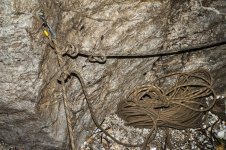I had some issues putting anchors into reef limestone in Castleton, both throughbolts and screws, most of which were down to the nature of the rock, which is probably worth considering as badly-mixed concrete, as the variability of density and homogeneity in any given area is enormous, and there's no real bedding sequences as such - plus the surfaces are very bumpy, even at small scales. Often there are small voids within the rock, and some bits just fall off with the slightest touch. Also lots of fossils and small mineral inclusions, even off the vein, as there's calcite pipes traversing through it too. We had to screw in direct to that sometimes (below).
Due to the need for endless moving and replacement as we sunk further down the shaft we had to use screws, and a hand-spanner was the only way really as you need to feel what it's going through, and abandoning if necessary. And lots of hammering first to test the sound, usually the best indicator.




